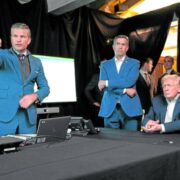Harnessing the heat: Transforming anger into a catalyst for leadership success

In the intense arena of corporate leadership, emotions are often viewed as hurdles rather than catalysts for growth. Among these, anger tends to be the most maligned—frequently seen as a destructive force that can damage relationships and tarnish reputations. However, when channeled correctly, the energy behind anger can be transformed into a powerful motivator for both personal and organizational advancement. Here, we explore how CEOs and top-level executives can convert anger from a perilous storm into a force that propels leadership and drives innovation.
Understanding the power of anger
Anger is a natural human emotion that signals something in our environment needs attention. It is often a response to perceived threats, injustices, or frustrations. Rather than suppressing this emotion, effective leaders acknowledge and analyze their anger, using it as a barometer for underlying issues within their organizations that require intervention.
Real-life examples of anger as a motivator
Understanding what not to do when it comes to managing anger is as crucial as knowing the right steps to take.
1. Steve Jobs and the birth of the iPhone
It is well-documented that Steve Jobs often used his temper as a tool to push his teams to achieve the impossible. When the idea of the iPhone was initially proposed, Jobs was furious with the current state of mobile phones. His anger was not directed at his team but at an industry that settled for mediocrity. This led to the creation of a device that revolutionized the tech industry.
On the flip side, Steve Jobs’ many uncontrolled outbursts of anger and frustration against his team have been well-documented. One thing is certain: He could have improved his leadership style and retention of top talent, ruling with respect instead of fear by getting his anger outbursts under control.
2. Elon Musk and the drive for perfection at Tesla
Musk is known for his intense commitment to quality and innovation, traits spurred by dissatisfaction and anger toward current automotive standards. His frustration with the status quo has propelled Tesla to make significant advancements in electric vehicles, demonstrating how anger can fuel breakthroughs that defy industry norms.
Examples of CEOs who struggled with anger management
1. Travis Kalanick, former CEO of Uber: His tenure at Uber was marked by various reports of aggressive management style and public outbursts. His confrontational approach contributed to a workplace culture that was widely criticized for being hostile, particularly toward women, ultimately leading to his resignation. Kalanick’s inability to manage his anger constructively is a cautionary tale of how negative emotional management can impact an entire organization’s culture and public image.
2. Michael Eisner, former CEO of Disney: He was often criticized for autocratic leadership style, particularly during the latter part of his tenure at Disney. His conflicts with colleagues, including a very public fallout with Disney’s then-president Michael Ovitz, were partly attributed to his temper. These conflicts were not only personal but had significant repercussions for the company, affecting its operations and public perception.
3. Carly Fiorina, former CEO of Hewlett-Packard: She faced criticism for her leadership style, which some described as high-handed and dismissive. Her tenure at HP was marked by significant strife within the company, culminating in her ouster in 2005. Her approach to conflict and anger management, often perceived as unyielding, strained her relations with other executives and the board.
Lessons from negative examples
These examples highlight the importance of handling anger with care. Leaders should strive to:
- Reflect before reacting. Take a moment to step back and assess the situation calmly before responding.
- Maintain professionalism. Keep personal emotions and professional actions distinct to ensure that the workplace remains a positive and productive environment.
- Seek constructive solutions. Focus on resolving the underlying issues that trigger anger rather than allowing the emotion to dictate responses.
- Foster open communication. Encourage a culture where issues can be discussed openly and without fear of retribution.
Transforming anger into constructive energy
Step 1: Acknowledge and reflect
The first step in harnessing anger is to recognize it without judgment. CEOs should ask themselves: What specific situation is causing this anger? Is it a personal trigger or a genuine business concern? Reflection can transform raw emotion into a thoughtful response.
Step 2: Communicate effectively
Anger often prompts a response that can lead to conflict. However, when channeled through effective communication, it can clarify expectations and reinforce objectives. Practicing assertive communication rather than aggressive confrontation can help in articulating thoughts more clearly, ensuring that the focus remains on solving problems rather than escalating them.
Step 3: Use anger as a diagnostic tool
Anger can be an excellent diagnostic tool to identify areas within the organization that need improvement. For instance, if a leader is consistently upset about delays in a particular department, it may be time to reevaluate the workflows or skill sets in that area. By identifying and addressing the root causes of frustration, leaders can implement constructive changes.
Step 4: Drive change and innovation
Once the roots of anger are understood, it can become a driving force for innovation. Leaders can channel their emotional energy into perseverance, pushing through challenges and driving their teams toward solutions. It is about converting the ‘heat’ of anger into the ‘light’ of creative solutions.
Step 5: Build a culture of openness
By handling anger constructively, leaders can model how to manage emotions effectively, encouraging a culture of openness and resilience. When team members see leaders using anger to advocate for positive change, they are more likely to feel empowered to express their concerns and ideas.
Conclusion
Turning anger into a positive force is not about denying the emotion but about leveraging it as a catalyst for change. Leaders like Steve Jobs and Elon Musk demonstrate that with the right approach, anger can not only motivate but also bring about pivotal innovations and lead to substantial organizational improvements.
For today’s CEOs and business executives, mastering the art of transforming anger into a productive force is essential. It requires mindfulness, self-awareness and a commitment to channeling intensity into strategies that benefit the individual and the company at large.
Tom Oliver, a “global management guru” (Bloomberg), is the chair of The Tom Oliver Group, the trusted advisor and counselor to many of the world’s most influential family businesses, medium-sized enterprises, market leaders and global conglomerates. For more information and inquiries: www.TomOliverGroup.com or email Tom.Oliver@inquirer.com.ph.
Tom Oliver, a “global management guru” (Bloomberg), is the chair of The Tom Oliver Group, the trusted advisor and counselor to many of the world’s most influential family businesses, medium-sized enterprises, market leaders and global conglomerates. For more information and inquiries: www.TomOliverGroup.com or email Tom.Oliver@inquirer.com.ph.


















